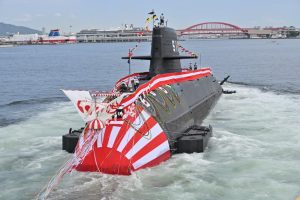Japan’s Kawasaki Heavy Industries (KHI) has launched the sixth Taigei-class diesel-electric attack submarine (SSK) on order for the Japan Maritime Self-Defense Force (JMSDF).
The new 3,000-tonne submarine, which has been named JS Sogei (with pennant number SS 518), entered the water on October 14 in a ceremony held at KHI’s facilities in Kobe City of Hyogo Prefecture.
JMSDF submarines are currently being pressed to expand their roles and missions as China, North Korea, and Russia are all flexing their military muscles around Japan. In particular, Japanese subs could be drawn into a Taiwan contingency, which has become an increasingly real possibility in recent years.
According to the JMSDF, the new submarine has a crew complement of about 70, an overall length of 84 meters, a beam of 9.1 m, a draught of 10.4 m, and a standard displacement of about 3,000 tonnes. It is just slightly larger than the well-known previous Soryu-class SSKs, which have a standard displacement of 2,950 tonnes.
The Sogei is expected to enter service in March 2027. Sogei means “blue whale” in Japanese. This is the first time that the JMSDF has named a vessel “Sogei,” and the former Imperial Japanese Navy had no vessel with this name.
The Taigei class is the first submarine in Japan to feature female-only compartments, including living quarters that can accommodate up to six women, according to the JMSDF.
The new submarine, which cost about 73.6 billion yen ($484 million) to build, is powered by a diesel-electric engine generating 6,000 hp. It has a maximum speed underwater of 20 knots.
The JMSDF said that the Taigei class is equipped with lithium-ion batteries in place of lead-acid ones, just like the final two Soryu-class boats for the JMSDF: the Oryu (SS 511) and the Toryu (SS 512).
GS Yuasa, a Kyoto-based developer and manufacturer of battery systems, provided the lithium-ion batteries for those new submarines. So far Japan is the only country known to have fitted lithium-ion batteries into SSKs, with South Korea expected to be the next country to do so with three 3,600-ton Jang Bogo-3 Batch 2 submarines. These South Korean vessels are scheduled to be commissioned from 2027.
The new Taigei class employs a “compact” and “highly efficient” electricity storage and supply system that extends the submarine’s endurance under water without the need to increase the size of the boats, according to the Japanese Ministry of Defense (MoD).
The class also employs a new combat management system (CMS) combining advanced integrated sensors, command-and-control, and weapon engagement systems, the MoD said.
In addition, it adopts an enhanced snorkel system to reduce signatures, and a new-generation sonar system based on fiber-optic array technology to enhance detection capability.
The Taigei class employs the same torpedo countermeasures system that has been incorporated into the last four Soryu-class submarines. It uses Japan’s newest torpedo, which is called the Type 18, succeeding the previous Type 89. The new torpedo features improvements in a number of areas, including propulsion, target detection, and processing.
The class is also capable of deploying the UGM-84L Harpoon Block II anti-ship missile against surface targets. This missile’s range is about 250 km – enough to provide the Japanese submarine with a “counterattack” capability.
The lead submarine of the Taigei class, the Taigei (SS 513), was commissioned in March 2022; a new member of the class has entered service every March since then. The fifth boat, the Chogei (SS 517), which was launched in October 2024, is currently undergoing outfitting and various tests in preparation for commissioning in March 2026.
On August 29, the Defense Ministry requested 119.9 billion yen for fiscal year 2026 (starting in April) to build the tenth SSK, or SS 522, of the class. This represents 1.5 times the construction cost of the first submarine, the Taigei, which was around 80 billion yen. The increase reflects the government’s decision to raise the expected operating profit margin for defense contractors producing ships and military aircraft – from around 8 percent to as much as 15 percent – in an effort to strengthen Japan’s defense industrial base. It also stems from the rising prices of materials and other commodities, which have continued to climb year after year, as well as the depreciation of the yen.
A JMSDF spokesperson told The Diplomat on October 14 that Tokyo has not officially decided on how many submarines of the Taigei class will be built, but it is likely that the total will be about 12. In Japan’s previous submarine production runs, 11 Oyashio-class ships and 12 Soryu-class ships were built.





























